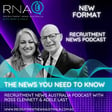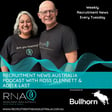Become a Creator today!Start creating today - Share your story with the world!
Start for free
00:00:00
00:00:01

Episode 55
News for the week beginning 1 April 2024 and Question of the Week: "Has the recruitment market returned to (the pre-COVID) normal?" ?"
#rna #recruitmentnewsaustralia #recruitmentpodcast
Transcript
Job Market Trends in Australia
00:00:08
Speaker
This is the news for the week beginning 1 April 2024. I'm Ross Clannett.
00:00:14
Speaker
Job ad volumes in Australia fell 2.5% in February after two months of increases according to SEEK's March employment report released last week. Job ads are now just 1.8% higher than February 2019 and applications per job ad are 50% higher, demonstrating that while demand for workers has returned to pre-COVID levels, interest among candidates is significantly higher, making for a much more competitive job market.
00:00:40
Speaker
Victoria, which has recorded the most consistent decline in job ads over the past 18 months, led the monthly decrease in February, dropping 3.6% month on month. This was driven by a 5.4% decline in the healthcare and medical sector and a 10% fall in administration and office support.
00:00:58
Speaker
Banking and financial services led the way among the five sectors that bucked the overall trend, with a 2.1% rise in job ads in February. Other sectors to record a rise were ICT, sport and recreation, science and technology, and advertising arts and media.
Competitive Job Applications
00:01:15
Speaker
Applications per job ad rose for the 18th consecutive month, increasing 2.9% from last month and 72.7% compared to January 2023.
00:01:26
Speaker
On a state basis, applications per job ad rose the most in Western Australia by 7%, followed by New South Wales at 5%. Four out of five businesses across New Zealand offered flexible working hours to their employees in 2023, according to data released last week by Statistics New Zealand. The research found that the offer of flexible working hours increases to 90% for businesses with 100 or more employees.
00:01:54
Speaker
In terms of industry, 95% of businesses within professional, scientific, and technical services offer the option of flexible working hours, followed by 94% of information media and telecommunications companies, and 92% of financial services and insurance businesses. Part-time work, 77%, was the second most popular offer across New Zealand businesses relating to flexible work and support provisions.
00:02:21
Speaker
Australia's population was 26.8 million people, as at the end of September last year, a quarter on quarter growth rate of 0.6%, according to the latest population data released last month by the ABS.
Population Growth Impact
00:02:35
Speaker
For the 12 months until 30 September, 2023, Australia added 659,800 new residents, of which 15% came from natural increase, with net overseas migration contributing 85% of the population increase.
00:02:49
Speaker
The 2.5% annual growth rate is the fastest for over 60 years. West Australia's 3.3% growth rate was the fastest of all states and territories, while Tasmania posted the lowest growth rate of just 0.3%. Victoria's population increased by the greatest number of people over the 12 months, 192,700, followed by New South Wales at 186,100, and Queensland welcomed 144,600 additional residents.
00:03:19
Speaker
The proportion of people over the age of 65 has reached a record high of 17.1%.
00:03:25
Speaker
proportion of people 17 or younger, which in the late 1970s was around 31%, has now fallen to 21.6%. In the five years between September 2018 and September 2023, the national population grew by 1.7 million people, or 6.3%. With WA, the fastest growing state over that period at 11.5%, followed by Queensland, 9.1%, and Victoria with 6.1% growth.
Post-Pandemic Employment Patterns
00:03:56
Speaker
The share of Boomerang employees, employees who returned to their former employers after having previously left their positions, has increased by around 30% following the pandemic, according to recently released data from the United States. The rate at which workers returned to a former employer increased from 2.6% in 2018 to 3.4% in 2023. Approximately 50% of workers returned within two years of their departure.
00:04:24
Speaker
and around 80% come back within five years. While boomerang rates have increased overall, they have increased faster in sectors with high seasonality and high growth, such as accommodation and food services, which recorded the highest boomerang rate of 5.4%, and healthcare and social assistance recording the third highest boomerang rate of 4.5%. The two sectors least likely to have returning employees were utilities and warehousing and transportation,
00:04:53
Speaker
both had a 2.1% boomerang rate.
Growth of Renewable Energy Jobs
00:04:57
Speaker
Employment in the renewable energy industry is set to surge according to a new report by staffing industry analysts. The industry is forecast to add close to 10 million new jobs globally over the next seven years. Demand for workers is driven by ongoing government and private sector support for renewable energy and firms are scrambling to find workers with the right skills.
00:05:18
Speaker
Energy companies around the world cite talent shortages and difficulty sourcing workers as one of their largest concerns about potential growth, writes Amy Horvat, SIA research analyst and author of the report. SIA defines renewable energy companies as those in one of the following fields, solar, wind power, hydropower, bioenergy, geothermal energy, and marine energy.
00:05:42
Speaker
Solar ranks as the top job generator accounting for 44% of all renewable energy jobs in 2023 and is forecast to create nearly 75% of all new renewable energy jobs through 2030. Horvat noted solar usage is growing faster than other types of renewable energy
00:06:00
Speaker
in part because it can be installed by individual consumers. The next biggest generator of renewable energy jobs was wind power, which is expected to contribute 15% of all new jobs in the sector through 2030. By location, China represents 33% of all renewable energy workers, followed by the US, Brazil and India. Improving staff wellbeing is the top driver for DEI in Australian organisations,
00:06:29
Speaker
According to a survey by software giant Workday Incorporated, it found that 46% of Australian firms said improving employee wellbeing drove their DEI program, followed by the need to attract and recruit a diverse workforce at 43%.
Focus on DEI Initiatives
00:06:45
Speaker
Workday's report also found that nearly all Australian respondents, 97%, have at least one DEI initiative in place. Firms also noted they are seeing results, with 72% reporting an increase in belonging and inclusion,
00:06:59
Speaker
and 51% reporting a boost in profitability. In recent years, DEI has gone from a nice to have to a priority, Joanne Rule, Managing Director of Workday ANZ, said in a press release. Australian organisations are moving to a point of maturity in their DEI approach now that they have a strong foundation. To move to the next stage in terms of DEI progress, 42% of business leaders said DEI metrics should be included as a core part of corporate
00:07:28
Speaker
performance indicators, 38% called for shared vision and understanding of the business case for DEI, and 37% cited leadership and a commitment from the top.
AI in Recruitment: UK Guidelines
00:07:41
Speaker
The Department for Science, Innovation and Technology in the UK has just released a Responsible AI in Recruitment Guide. The government's guidance was developed with feedback and contributions from bodies including the Recruitment and Employment Confederation and APSCO. The guide is aimed at organisations seeking to procure and deploy AI systems in their recruitment processes. It is written for a non-technical audience. It assumes a minimal understanding of AI
00:08:08
Speaker
and data-driven technologies. The guidance outlines a range of considerations for all organizations relating to procurement and deployment of AI in recruitment. Alongside this, the government outlines options for mechanisms that may be used to address concerns, actions, or risks identified as a result of these considerations. The guide is free to download and can be found by using the search words, responsible AI in recruitment guide.
00:08:36
Speaker
And that's your news up to date for week commencing the 1st of April, 2024. I'm Adele Last. Question of the week this week is based on some of the data that we just heard around job applications increasing, they've increased by 50% according to the SEEK data.
Current Job Market Dynamics
00:09:03
Speaker
So does this increase in job applications
00:09:05
Speaker
mean the market is back to normal? What do you think? No, no, no, no, no is the short answer. And here's why the answer is no. The unemployment rate in February dropped from 4.1% in January to 3.7% of February. So unemployment, the unemployment rate has gone back down.
00:09:29
Speaker
Job vacancies are still nearly 60% higher than they were in March 2020. So we're at about 360,000 thereabouts.
00:09:45
Speaker
And you've also got from the Jobs and Skills Australia data that was part of the news last week, that 26% of employers are forecasting an increase in headcount in the upcoming three months. And in two months, that's jumped from 20%
00:10:04
Speaker
So it's gone from 20% of employees forecasting a headcount increase the next three months to 26%. So the indicators are very strong and different data points supporting the fact that the job market is still pretty hot and it's going to continue to get hot. So I would assert
00:10:26
Speaker
that the seek job ad data is misleading. I'm not saying it's inaccurate, it's misleading, and it's going to potentially create a false sense that things are back to normal with many employers, and I suppose some recruiters as well. But where are these people coming from? A large 50% increase, who are these people that are applying and why?
00:10:51
Speaker
Well, again, I think we can point to the news that we just read, Adele, and therein lies the clue. Because if you see that 85% of the increase in Australia's population is coming from overseas migration and a large proportion of people coming in from overseas are entering the workforce immediately, it's pretty, you know, it doesn't take much to work out.
00:11:20
Speaker
the fact that many of the people applying for these jobs and accounting for a significant amount of the additional people applying are going to be students or people coming in on temporary visas, people without Australian work experience, people who are on restricted hours if they're a student and people who are also likely to be at the low skill level of the market.
Remote Work Demand
00:11:47
Speaker
So that's
00:11:48
Speaker
probably where you're seeing a lot of additional applications coming from. OK, so if we accept that a lot of them might be new migrants that are applying and that could be increasing the numbers, that can't be the full picture, though. There's got to still be a lot of local Australian residents and citizens applying as well, or people that are on the ground here already applying for jobs in those numbers. So what are the other factors there?
00:12:13
Speaker
Well, the other factors again come from SEEK data. I've just looked at the most popular search terms on SEEK for the year until March, 2023. So it's a little bit out of date, but I suspect it's probably still reasonably current. And do you know what the number one search term was on SEEK across that whole 12 month period, Adele? No, no idea. Work from home. Of course.
00:12:39
Speaker
So what that is indicating to me is that what's driving many people to apply for jobs is that maybe they're not in the workforce at the moment and they're looking for jobs where they don't have to leave home or they've been part of the
00:12:56
Speaker
proportion of people that were given remote work options in the pandemic lockdown and immediate post pandemic lockdown periods. But those options have been curtailed and those workers don't like it. And so they're looking for new jobs. And there were two other significant search terms in SEEK's top seven search terms, number six and seven. And you want to guess what those were? No, Tully.
00:13:26
Speaker
So number six was no experience. And number seven was part time. So again, suggesting that many people entering the workforce for the first time, either Australian residents or people coming into Australia have little experience. So they're looking for entry level work. And also people who are typically parents returning to work or students are looking for part time work.
00:13:54
Speaker
So that indicates again, very strongly a large proportion of the people who are applying for these jobs are people who generally want remote work, generally not very experienced and generally wanting part-time work. So you're sort of suggesting that the quantity does not mean quality in the current market. Exactly. You're saying that we're still seeing a market of
00:14:24
Speaker
constriction around candidate supply, difficulty to find good people with the right qualifications and the right levels of experience? Yes, without that, and I suspect
00:14:38
Speaker
So what does that mean for? Recruiters are going to find. Recruiters are going to find. It's very difficult. Like, it really hasn't changed that much for many positions. It's still really difficult to find good people. And of course, the added difficulty is employers think, oh, the market's better.
00:14:59
Speaker
for candidates, I don't have to be as flexible with pay. I don't have to be as flexible in terms of remote work options. And they're going to scale back the very things that employees are looking for, things that will be a big incentive for them to leave their current job and take a new one.
00:15:22
Speaker
So recruiters in the current market are really having to struggle between having to now manage a large quantity
Recruitment Challenges and Misconceptions
00:15:29
Speaker
of applications. So there's a lot more work and volume to process. They've gone from very scarce sourcing to having to screen and sort through large volumes of people to find the people that they need, find the right quality of candidates to be able to present their clients. And then on top of that, manage expectations of clients
00:15:52
Speaker
who might really be based on this big headline data in the media, things are back to normal. Things are looking good. I can advertise a job and get a large number of applications. What's the problem? So recruiters are having to manage client expectations around that idea that the quantity does not necessarily mean the right quality for your job.
00:16:16
Speaker
Exactly. So in other words, it's the illusion that the market has returned to normal. And that seek data which basically says same number of job ads as five years ago, and 50% greater applications creates the illusion
00:16:36
Speaker
that the market is somewhat back to normal. But it is anything but. And this is where recruiters need to be armed with facts so they don't get sucked in by the clients attempting to tell them that the market's back to normal and I don't have to pay as much or I don't have to be as flexible with remote work, for example.
00:17:02
Speaker
And that's why this sort of discussion we're having, Ross, is so critical for many recruiters in the market and even hearing our news. We don't plug ourselves too often, but listening to our podcast every week is giving you that data. It's giving you the information behind the headlines. It's giving you conversations to have with clients about how to dissect this, about what's really going on in the market, and having those educated, data-driven conversations with clients.
00:17:28
Speaker
That's right Adele, and of course what we would recommend very strongly is not just highly effective recruiters listen to RNA every week to get their dose of news and data that maybe they should suggest to their clients that if those clients don't believe the recruiters about the way the market is, subscribe to RNA because you'll hear it straight from us every week. I love it. We welcome all recruiters and their clients from now on.
00:17:58
Speaker
Looking forward to it.





